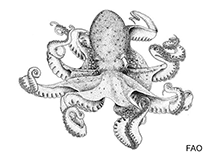Pinnoctopus cordiformis (Quoy & Gaimard, 1832)
Google image | No image available for this species;
drawing shows typical species in Octopodidae.
Classification / Names Populärnamn | synonymer | CoL | ITIS | WoRMS
Cephalopoda | Octopoda | Octopodidae | Octopodinae
Environment: milieu / climate zone / djupintervall / distribution range Ekologi
Revassocierade; djupintervall 0 - 300 m (Ref. 122140). Subtropical; 14°C - 22°C (Ref. 122726); 28°S - 48°S, 129°E - 171°W
Distribution Länder | FAO områden | Ekosystem | Förekomster | Utplanteringar
Indo-West Pacific: Australia, New Zealand and Chatham Island.
Length at first maturity / Size / Weight / Age
Könsmognad: Lm ? range ? - ? cm Max length : 200 cm TL hane/ej könsbestämd; (Ref. 122140); publicerad maxvikt: 2.3 kg (Ref. 122140)
Life cycle and mating behavior Könsmognad | Reproduktion | Lek | Eggs | Fecundity | Larvae
Main reference
referenser | Koordinator | Medarbetare
Carrasco, S.A. 2014 The early life history of two sympatric New Zealand octopuses: eggs and paralarvae of Of Octopus huttoni and Pinnoctopus cordiformis. New Zealand Journal of Zoology 41(1):32-45. (Ref. 122140)
IUCN Red List Status
(Ref. 130435: Version 2025-1)
CITES status (Ref. 108899)
CMS (Ref. 116361)
Threat to humans
Human uses
Fiskeri: kommersiell
| FishSource |
Verktyg
Ytterligare information
Max. ages / sizes
Length-weight rel.
Length-length rel.
Length-frequencies
Mass conversion
Abundans
Internet-källor
BHL | BOLD Systems | CISTI | DiscoverLife | FAO(Publication : search) | Fishipedia | GenBank (genome, nucleotide) | GloBI | Gomexsi | Google Books | Google Scholar | Google | PubMed | Tree of Life | Wikipedia (Go, sök) | Zoological Record



